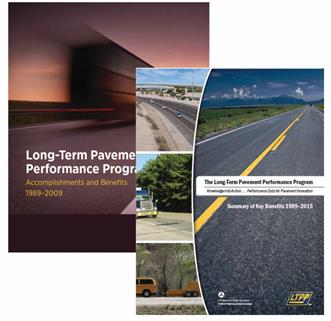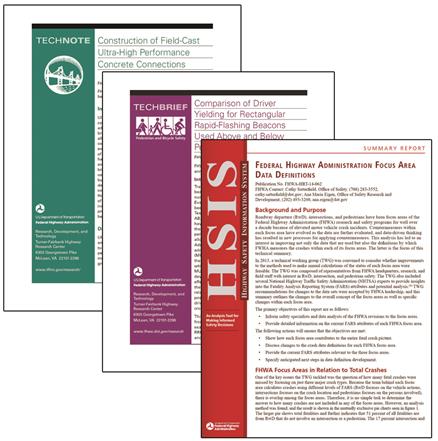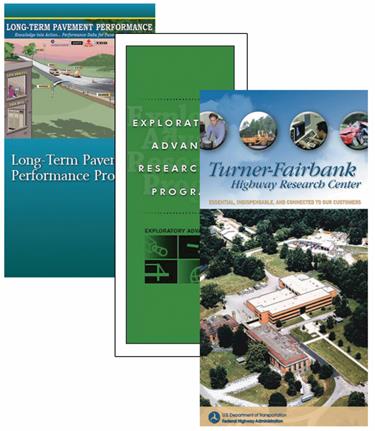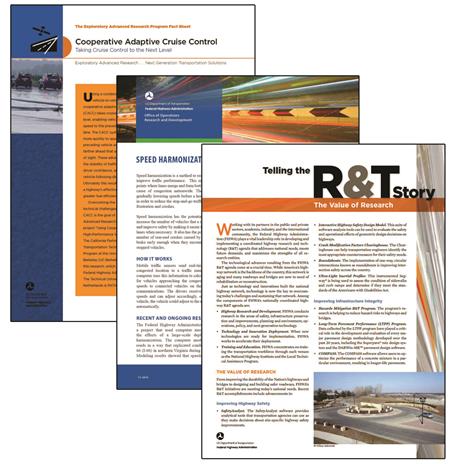U.S. Department of Transportation
Federal Highway Administration
1200 New Jersey Avenue, SE
Washington, DC 20590
202-366-4000
Federal Highway Administration Research and Technology
Coordinating, Developing, and Delivering Highway Transportation Innovations
| REPORT |
| This report is an archived publication and may contain dated technical, contact, and link information |
|
| Publication Number: FHWA-HRT-15-058 Date: February 2017 |
Publication Number: FHWA-HRT-15-058 Date: February 2017 |
There are a variety of documents that each office may use to communicate with a specific audience, including booklets (see figure 15), technical flyers (e.g., TechBriefs, report summaries, and product application notes), brochures, fact sheets, and newsletters. Please refer to chapter 4 and the GPO Style Manual for additional editing and style requirements.(2)

Figure 15. Photo. Cascade of booklet cover examples.
To communicate detailed summaries, achievements, and recommendations from research projects and programs.
Transportation managers, decisionmakers, and executives.
Publication length is usually fewer than 40 pages.
Publication types include guidebooks, executive summaries, and annual reports.
Covers are full- or two-color with up to two-color text pages.
Design should include eye-catching graphics that illustrate the project.
Publications must include a foreword and a standard disclaimer notice at the bottom.
There are several types of flyers, including TechBriefs and Application/Technical Notes (see figure 16).

Figure 16. Photo. Cascade of technical flyers.
To summarize an experiment, TechBriefs provide results, data collected from analysis, or findings and recommendations.
To provide technical information and benefits about an FHWA product or research findings used by an FHWA customer.
Transportation managers and technical staff.
Two-color publication.
Usually 2 to 16 pages in the following page numbers: 2, 4, 6, 8, 12, 16.
Signature colors assigned to RD&T offices and teams.
Standard information about the research program area and key resources.
Back matter information about availability, keywords, and distribution.
The following components are needed for each TechBrief (which must be a minimum of 2 pages):
Logo and the word “TechBrief.”
Organization name, office name, and address.
Publication number in this format: Publication No. FHWA-HRT-##-###.
Distribution and Publishing Information No: XXXX-##/##-##(#M)E.
Contact information in the following format:
Technical content, including the following minimum items:
Objective.
Introduction (sometimes includes Background).
Methodology (or Approach).
Results (can be broken down according to testing analysis).
Conclusion (sometimes Recommendations).
References.
Distribution and Standard Disclaimer containing the following (sample) elements:
Researchers—This study was performed by name of organization and office and researcher and lab if FHWA or Contract No. DTFH61-06-C-00027 if not FHWA.
Distribution—This TechBrief is being distributed according to a standard distribution. Direct distribution is being made to the FHWA divisions and Resource Center.
Availability—The publication associated with this TechBrief is Curl and Warp Analysis of the LTPP SPS-2 Site in Arizona (FHWA-HRT-12-068). It is available in print and online at http://www.fhwa.dot.gov/research.
Key Words—Insert keywords and phrases here.
Notice—This document is disseminated under the sponsorship of the U.S. Department of Transportation in the interest of information exchange. The U.S. Government assumes no liability for the use of the information contained in this document. The U.S. Government does not endorse products or manufacturers. Trademarks or manufacturers’ names appear in this document only because they are considered essential to the objective of the document.
Quality Assurance Statement—The Federal Highway Administration (FHWA) provides high-quality information to serve Government, industry, and the public in a manner that promotes public understanding. Standards and policies are used to ensure and maximize the quality, objectivity, utility, and integrity of its information. FHWA periodically reviews quality issues and adjusts its programs and processes to ensure continuous quality improvement.
For printing purposes, the TechBrief layout must be in one of the following formats, and the finished product is 8.5 by 11 inches:
2 pages (rarely used because it is difficult to include all technical elements).
4 pages (stitched).
6 pages (tri-fold, no stiches).
8 pages (stitched).
12 pages (stitched).
16 pages (stitched).
To create awareness or attract interest in a specific project or program, brochures (see figure 17) communicate the benefits of a research, technology, or service.

Figure 17. Photo. Cascade of marketing brochures.
Transportation decisionmakers, senior executives, managers, and technical staff.
Two-color or full-color publication.
Visually appealing graphics and layout attract awareness and interest in a subject area.
Information or a call to action that asks the reader to act in some manner for additional information, a service, or participation in a program.
To provide concise, factual information about a specific topic such as a facility, laboratory, technology, or subject area (see figure 18).

Figure 18. Photo. Cascade of fact sheets.
Transportation decision makers, managers, technical staff, and students.
Concise and informative.
2 pages (1 page back and front).
Usually one or two colors.
Text and graphic layout have a similar design if part of a series.
Templates for creating FHWA publications are available on the FHWA Research Publication Development Web page at http://www.fhwa.dot.gov/research/publishing/. See table 5 for the list of submission requirements for booklets, flyers, brochures, and fact sheets.
Table 5. Booklets, flyers, brochures, and fact sheets—what to submit.
One Color Print (.doc) |
Two- or Four- Color Print (.doc and .qxd) |
Website Only (.doc) |
Submission Requirements for Booklets, Technical Flyers, Brochures, and Fact Sheets from the Contracting Officer’s Representative (COR) |
|---|---|---|---|
| • | • | • | HRTM Service Request Form |
| • | • | • | Microsoft® Word file of document |
| • | • | • | Microsoft® Word file of 508 captions or alternative text |
| • | • | — |
FHWA Distribution Form and either labels or a Microsoft® Excel file with names and complete addresses |
| • | • | • | Tables, charts, and graphs in separate native file formats (Microsoft® Excel files for tables and .jpg or .tif files for graphic and CAD files) |
| • | • | • | Equations in .jpg file formats |
— |
— |
• | Low-resolution illustrations and figures in .jpg, .tif, or .bmp file formats |
| • | • | — |
Digital graphics with high resolution (300 to 1,260 dpi or greater), and at least 4 by 6 inches or equivalent pixel sizes in separate native file formats |
| • | • | — |
GPO Form 952 - |
| • | • | • | PDF file of the document after final edit |
| • | • | — |
Adobe® InDesign, Adobe® Illustrator, or other graphic design files after the files have been edited. Include all text, font files, and graphic files. |
—Submission not required.
Do not submit second-generation or previously printed materials as graphics. Do not use correction fluid, tape, photocopies, or artwork that is fuzzy, dark, or faded. Do not submit CAD drawings; export them to a .jpg or .tif format.
Provide the following items on a separate CD or DVD for each, labeled with the date, researcher name, publication name, publication number, and one of the following designations: GPO, Web, HRTM, or NTIS, depending on the content:
Salutation.
First Name.
Last Name.
Title.
Name of Company.
Address Line 1.
Address Line 2.
City.
State.
ZIP Code™.
Country Code.
Number of Copies.
Web files (on CD or DVD): Microsoft® Word text, Section 508 captions for all nontext elements, graphic files, Microsoft® word files for the Web, and high- and low-resolution PDF files.
HRTM files: All files included in the GPO and Web file sets.
NTIS files: Low-resolution PDF files, Microsoft® Word files, and Section 508 caption files for all nontext elements.
The purpose of trade publication articles is to inform and promote advances and innovations in transportation research and technology (R&T), critical national transportation issues, important activities and achievements of FHWA and others in the highway community, specific FHWA program areas, and subjects of interest to highway industry professionals.
The audience varies from journal to journal. The audience will typically include one or more of the following: Federal, State, municipal, and foreign transportation officials, planners, and researchers; association leaders; engineering professors and students; transportation reporters and trade media representatives; and members of Congress.
The format and issues vary from journal to journal.
The circulation varies from journal to journal.
A trade publication may be an appropriate vehicle to provide information to your intended audience. If so, please contact HRTM for writing or editing articles for trade publications. Any R&T technical articles submitted for publication in journals and magazines outside FHWA must be edited by HRTM. Upon final edit and review, HRTM will submit the article to HPA for final review and submission to the magazine or journal. To publish articles in trade publications, please do the following:
Provide guidance to HRTM regarding the trade publication style, deadlines, and editorial office contacts.
Provide HRTM with your article idea and substantial background information from which to draft the article, or provide a draft version of the article for HRTM to edit.
Include illustrations (print, slides, or electronic images) to support the text. Generally, a minimum of 1 illustration for every 600 words is required.
Include the author’s name, professional title, employer/organization/office, mailing address, telephone number, fax number, and email address. Also attach a short biographical paragraph about each author, including previous positions relevant to the subject of the article and educational background/degrees received. If applicable, also include the State(s) where an author is licensed as a professional engineer.
A periodical is defined as a publication that is published on a regular basis such as monthly, bimonthly, quarterly, weekly, or daily. Periodicals include magazines, newsletters, newspapers, or updates. Every issue of every periodical distributed to the public must be edited and then reviewed by the HPA.
Public Roads and several other FHWA periodicals provide unique vehicles for presenting the latest news on your program to the transportation community.(49) The following description gives details on the purpose, audience, format, circulation, submission guidelines, technical review, style, policies, and schedule of Public Roads.
The purpose of Public Roads is to inform and promote advances and innovations in transportation R&T, critical national transportation issues, important activities and achievements of FHWA and others in the highway community, specific FHWA program areas, and subjects of interest to highway industry professionals.(49)
The Public Roads audience includes Federal, State, municipal, and foreign transportation officials, planners, and researchers; association leaders; engineering professors and students; transportation reporters and trade media representatives; and members of Congress.
The 64-page magazine is published bimonthly by FHWA.
The total print circulation for each edition of Public Roads is 5,000 copies.
Contributors to Public Roads include Federal, State, and local governments; transportation industry organizations; associations; and academic institutions.(49) Articles are reviewed and considered by the Public Roads Editorial Board.(44) The Public Roads Editorial Board is comprised of the FHWA executive director, associate administrators, and select office directors who are also subject matter experts in the field of highway transportation issues.
If you are interested in publishing an article in Public Roads, please contact HRTM.(49)
The magazine is distributed every other month, with submissions due approximately 5 months before the publication date of each issue: January/February (deadline is July 1), March/April (deadline is October 1), May/June (deadline is December 10), July/August (deadline is February1), September/October (deadline is March 21), and November/December (deadline is May 21).